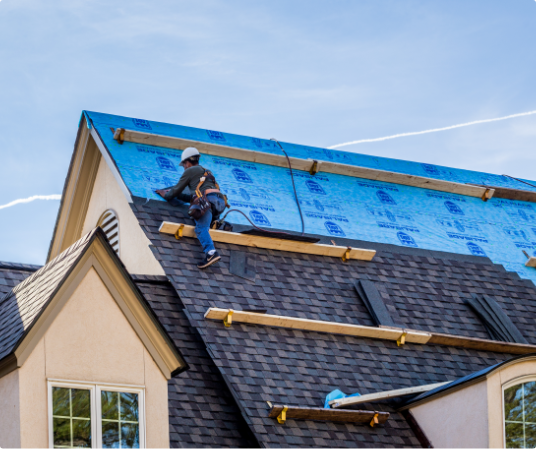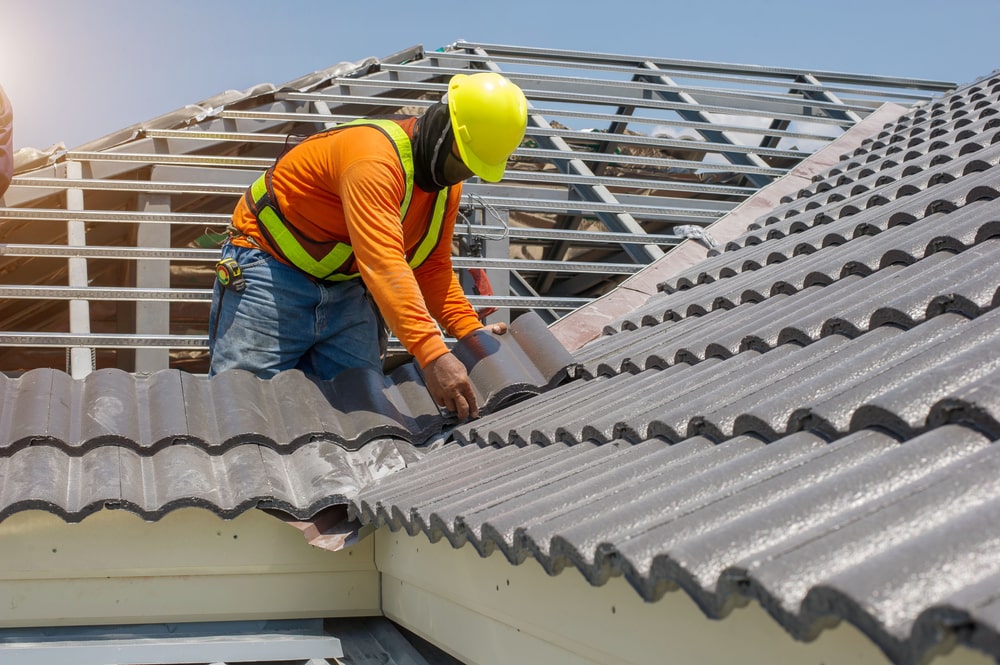Regional Insights on Roofing Companies Gainesville Florida Homeowners Prefer
Regional Insights on Roofing Companies Gainesville Florida Homeowners Prefer
Blog Article
Ideal Practices for Ensuring Appropriate Roofing Ventilation
Making sure appropriate roof ventilation is critical for the long life and performance of a roof covering system. A well balanced intake and exhaust air vent proportion, generally 1:300, plays an essential function, with intake vents preferably placed at the reduced edge of the roof covering for awesome air access and exhaust vents at the peak for cozy air leave. Regular inspections to identify clogs and keep clear air movement are paramount. Maintaining insulation away from vents is vital to avoid air flow limitation. Comprehending these fundamental components establishes the phase for more thorough understandings into installation and maintenance practices that can dramatically enhance your roof system's efficiency.
Understand Air Flow Fundamentals
Correctly recognizing air flow fundamentals is necessary for ensuring the durability and performance of roof. Effective air flow alleviates wetness build-up and temperature extremes in the attic, both of which can result in significant structural damage gradually. A well-ventilated roofing system helps in protecting against common issues such as mold and mildew development, wood rot, and ice dams, which can jeopardize the stability of the roof covering products and the underlying structures.
The primary objective of ventilation is to help with the activity of air, permitting for a regular exchange in between the interior and outdoor settings. This balance is achieved through a combination of consumption and exhaust vents that work together to maintain ideal air flow. Consumption vents, usually situated along the eaves or soffits, enable fresh air to get in the attic room space, while exhaust vents, typically located at or near the roofing ridge, allow hot, humid air to get away.
Secret aspects affecting the performance of roofing air flow consist of proper placement, sufficient sizing, and guaranteeing that both intake and exhaust vents are unhampered. Normal inspection and maintenance are critical to determine prospective clogs, damage, or inadequacies in the ventilation system, thus protecting the roof's performance and sturdiness.
Kinds of Roof Covering Vents
Roof covering vents play an important role in keeping efficient attic room ventilation and, by expansion, the total health and wellness of the roofing system. Different kinds of roofing system vents are offered, each with special benefits customized to particular roof covering demands.

Soffit vents are installed under the eaves and work in tandem with roofing vents to guarantee a balanced intake and exhaust system. By enabling cooler air to enter from below, soffit vents assist in the expulsion of warm air through top vents. Gable vents, situated on the exterior walls of the attic, offer another reliable solution, specifically in homes with saddleback roofs.
Examine Your Present Ventilation

Following, take into consideration the age and problem of your roof products and air flow elements. Older systems may not abide with current building codes or may have degraded with time, decreasing their performance. Conduct visit homepage a comprehensive exam to determine any indications of damage, such as rust, damages, or gaps that can compromise the system's efficiency.
Additionally, determine the attic temperature level and moisture levels. High temperature levels and moisture can suggest inadequate air flow - gainesville roofing companies. Utilize a hygrometer and thermostat to acquire precise readings, contrasting them with exterior conditions. Persistent discrepancies suggest prospective issues that need attending to.
Installment Best Practices
Effective installation of roof covering air flow systems is critical for ensuring ideal performance and long life. Correct installation starts with understanding the certain ventilation demands of the building and the roof covering it covers. This entails calculating the right proportion of consumption to exhaust vents, commonly sticking to the 1:300 guideline, which specifies one square foot of air flow for every single 300 square feet of attic room floor room.

The positioning of vents is just as crucial. Intake vents must be mounted at the roofing system's reduced side, typically in the soffits, to permit trendy air to get in. Exhaust vents, on the other hand, need to be installed near or at the roofing's height to promote the departure of warm, damp air. This develops an all-natural air flow that assists preserve temperature and moisture balance within the attic area.
Seal all air vent connections thoroughly to avoid air leakages and prospective water infiltration. Use top notch products and comply with manufacturer guidelines to guarantee sturdiness and efficiency. Additionally, integrating ridge vents with baffles can dramatically improve air flow effectiveness by avoiding wind-driven rainfall and snow from entering the attic.
Eventually, precise installation of roof covering air flow systems alleviates possible issues such as mold and mildew development, ice dams, and structural damages, ensuring the roof's stability and the building's total health and wellness.
Normal Maintenance Tips
Uniformity in upkeep techniques is essential to making sure the lasting efficiency of roofing ventilation systems. Routine evaluations are vital, preferably performed biannually-- in the spring and fall. Throughout these assessments, ensure that vents are devoid of debris, nests, and various other obstructions that might hamper air flow. Inspect for any indications of wetness accumulation or mold and mildew, as these can show improper here ventilation or leakages (gainesville roofing companies).
Cleaning the vents is one more crucial task. Make use of a soft brush or a vacuum cleaner to remove dust and particles from consumption and exhaust vents. Beware not to harm the vent screens or louvers throughout the process. Furthermore, examine the attic space for any indicators of water damage, which might compromise the honesty of the roof system.
Appropriate insulation is similarly crucial. Make sure that attic room insulation does not here obstruct the vents, as this can drastically limit airflow. Rearrange or replace it to maintain a reliable barrier. if any type of insulation has actually shifted or cleared up.
Lastly, change any damaged or missing out on components quickly. Busted vents, split tiles, or worn-out blinking can all contribute to poor air flow and should be attended to immediately. Routine maintenance guarantees that the roof covering ventilation system works optimally, therefore prolonging the lifespan of the roof itself.
Final Thought
Guaranteeing correct roof ventilation is extremely important for keeping the efficiency and longevity of a roof covering system. Adherence to the 1:300 intake and exhaust vent proportion, coupled with the tactical placement of vents, is essential. Routine biannual assessments, particles cleaning, and guaranteeing insulation does not obstruct air movement are crucial methods. Carrying out these ideal practices will certainly promote a well-ventilated roof system, consequently alleviating prospective problems associated with moisture buildup and excessive heat, eventually prolonging the roof's life expectancy.
A well balanced consumption and exhaust air vent proportion, frequently 1:300, plays a critical function, with consumption vents preferably positioned at the lower side of the roofing for awesome air entry and exhaust vents at the peak for cozy air leave. Intake vents, typically situated along the soffits or eaves, enable fresh air to enter the attic room area, while exhaust vents, typically positioned at or near the roofing ridge, make it possible for hot, damp air to get away.
Soffit vents are installed under the eaves and job in tandem with roof covering vents to make certain a balanced consumption and exhaust system. By enabling cooler air to go into from below, soffit vents promote the expulsion of hot air through upper vents. Adherence to the 1:300 consumption and exhaust air vent ratio, paired with the critical placement of vents, is necessary.
Report this page